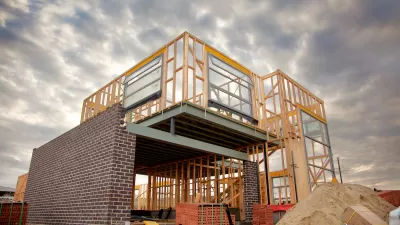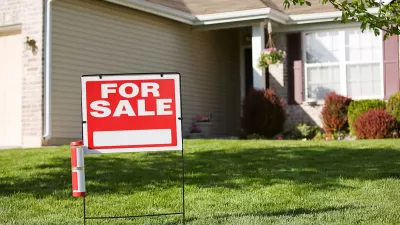Sara Robinson explains how the historical view of American homeownership -- that of a life-long commitment to place and "housey goodness" with no expectation of financial gain -- may be coming back.
Writing for Alternet, Robinson reminds us that the perception of the house as an investment is a recent one. Instead, previous generations of homeowners chose their houses for the long-term purpose of raising a family and becoming settled in a neighborhood. Now observers of the American housing market are noting that this view is making a comeback:
"Historically, most generations of Americans have expected to get back out of their houses no more and no less than exactly what they put into them. And even at that, they thought it was still a deal very much worth making. [But] by the mid-'80s, the old expectation that a middle-class life would be defined by one job and one house had almost completely given way to a new, harder-edged view. A house wasn't anything to get emotional or romantic about, let alone to commit your life to. Beyond a certain point, you didn't make the place pretty or comfortable for yourself; rather, you focused on the improvements (an updated kitchen, a new deck) that would increase your profit at the next sale. It was just a financial instrument you bought, hung onto for a while while it appreciated, and then sold at a hefty profit so you could move on to something better.
[Now] there are signs that the deep expectations and motivations of American homebuyers are changing. The economic crash has created some deep ontological shifts in how we value homes and home ownership. The early signals are starting to suggest that we're on a return trip back to a much older American tradition of home ownership – one that assessed a home's primary value not on the basis of its price on the open market, but for what it offered intrinsically to families in terms of security, stability and self-sufficiency."
FULL STORY: How Homeownership Has Changed in America And Why You Shouldn't Give Up on Buying

Coming Soon to Ohio: The Largest Agrivoltaic Farm in the US
The ambitious 6,000-acre project will combine an 800-watt solar farm with crop and livestock production.

Pennsylvania Mall Conversion Bill Passes House
If passed, the bill would promote the adaptive reuse of defunct commercial buildings.

U.S. Supreme Court: California's Impact Fees May Violate Takings Clause
A California property owner took El Dorado County to state court after paying a traffic impact fee he felt was exorbitant. He lost in trial court, appellate court, and the California Supreme Court denied review. Then the U.S. Supreme Court acted.

Colorado Bill Would Tie Transportation Funding to TOD
The proposed law would require cities to meet certain housing targets near transit or risk losing access to a key state highway fund.

Dallas Surburb Bans New Airbnbs
Plano’s city council banned all new permits for short-term rentals as concerns about their impacts on housing costs grow.

Divvy Introduces E-Bike Charging Docks
New, circular docks let e-bikes charge at stations, eliminating the need for frequent battery swaps.
City of Costa Mesa
Licking County
Barrett Planning Group LLC
HUD's Office of Policy Development and Research
Mpact Transit + Community
HUD's Office of Policy Development and Research
Tufts University, Department of Urban and Environmental Policy & Planning
City of Universal City TX
ULI Northwest Arkansas
Urban Design for Planners 1: Software Tools
This six-course series explores essential urban design concepts using open source software and equips planners with the tools they need to participate fully in the urban design process.
Planning for Universal Design
Learn the tools for implementing Universal Design in planning regulations.


























